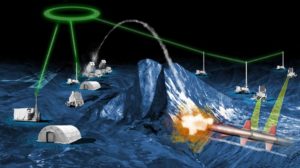The U.S. Army successfully intercepted a cruise missile in a record-breaking long-range flight test on Thursday using the Patriot Advanced Capability-3 (PAC-3) interceptor with the Integrated Air and Missile Defense (IAMD) Battle Command System (IBCS).
The Army and Northrop Grumman [NOC] used a PAC-3 interceptor with the Army’s IAMD IBCS as well as both Sentinel and Patriot radars. Northrop Grumman noted the test demonstrated IBCS’ ability to detect, track, and engage a low-flying air-breathing threat target at a range farther than the current Patriot system alone.

The test started at White Sands Missile Range, N.M., where a drone target served as a cruise missile surrogate. It flew a low altitude trajectory against an asset defended by an IAMD task force. Defensive forces consisted of battery and batallion IBCS engagement operations centers, one Patriot radar, two Sentinel radars, and two PAC-3 launchers connected at the component level to the IBCS integrated fire control network, Northrop Grumman said.
The target’s low altitude path was outside the Patriot radar’s field of view, so IBCS used measurement data from the Sentinel radars “to form a composite track from which IBCS calculated and presented the engagement solution,” the company said. Then, the operations center commanded the launch of one PAC-3 interceptor via the IBCS mission control software.
Lockheed Martin [LMT] underscored this was specifically a PAC-3 Cost Reduction Initiation (CRI) model, marking the furthest distance the CRI missiles has intercepted such a target while connected to the IAMD IBCS.
“The August flight test further demonstrates the critical role IBCS plays in integrating fires and sensors to defeat stressing threats,” Maj. Gen. Rob Rasch, Army Program Executive Officer, Missiles and Space, said in a statement.
Rasch added that an IBCS-enabled patriot batallion is currently in new equipment training and soldiers will spend the next months learning how to use the system and executing simulated battles before starting operational testing and live-fire exercises in summer 2020.
“This week’s successful event validates the interoperability of the system and the maturity of the hardware and software design in support of ongoing soldier training and testing,” Rasch said.
“This is an important event proving IBCS ability to enable next-generation concepts such as ‘engage-on-net.’ This flight test also shows how IBCS ‘extends the battlespace’ to allow ‘shoot-look-shoot’ opportunities, maximizing the probability of destroying the threat, which is critical as threats increase in sophistication,” Dan Verwiel, vice president and general manager for missile defense and protective systems at Northrop Grumman, said in a statement.
“The successful test – with IBCS in a near-operational environment – provides confidence IBCS is delivering transformational warfighting capabilities, including all the advantages of intercepting a threat close to its origin,” he added.
While the company did not disclose the added range this test proved, Mark Rist, IBCS program director at Northrop Grumman told Defense Daily “the significance of this test is that it demonstrates IBCS is able to detect, track, and engage threats at much greater ranges than possible with individual systems.”
He reiterated IBCS does not just pass information to the Patriot, but helps the components become a new system and work as one unit.
“In this test, the PAC-3 interceptor was launched before the Patriot radar had detected the threat. IBCS merges data from all available sensors to allow the warfighter to take advantage of the maximum range of existing weapons and expand the size of the area they can defend,” Rist added.
Lockheed Martin underscored this demonstrated the hit-to-kill capability of the PAC-3 family of missiles and reconfirmed the CRI ability to detect, track, and intercept incoming air-breathing threats or missiles.
“PAC-3 continues to be successful against today’s evolving threats, and this most recent test validates its effectiveness at long distance while integrated into the AIAMD architecture,” Scott Arnold, vice president and deputy of Integrated Air and Missile Defense at Lockheed Martin Missiles and Fire Control, said in a statement.
The IBCS seeks to replace legacy stove-piped systems with one that integrates separate radars and weapons to make a more effective air and missile defense system. It is managed by the Army’s Program Executive Office for Missiles and Space in Redstone Arsenal, Ala.
The PAC-3 CRI is a high-velocity interceptor that targets ballistic missiles, cruise missiles and aircraft.